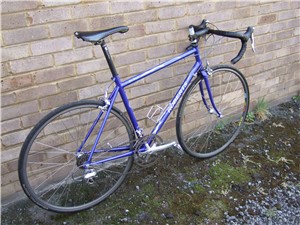




Renovating a “modern classic” road bike recently, I found myself carried back in time to the mists of 1997, when the technological contest between Campagnolo and Shimano ramped up to a degree not seen since the introduction of dual control shifting, first by Shimano with STI (Shimano Total Integration) in 1991 and then by the Italian company with Ergopower in 1992.
The two groupsets competing for top dog status were, of course, Dura-Ace and Record and the novelty most loudly hailed was the addition of a ninth rear sprocket. There was more, though; Campagnolo Record 9-Speed showcased for the first time brake levers in carbon fibre with a new, rounded lever and hood shape. The crankset was remodelled, sprockets made in titanium and the overall effect was more delicate that that achieved by the preceding 8-Speed gruppo.
On the Shimano front, the ageing and unlovely 7400 Dura-Ace groupset was replaced by 7700, which incorporated technology given its debut a year earlier with the eight-speed XTR mountain bike group. As well as sticking with the external derailleur gear cables running inboard from the levers’ shift mechanism, the new components stayed with tried and tested materials – aluminium alloys and high-strength plastics – while adopting titanium for the larger cassette sprockets.
The best stuff, however, was not readily visible: a fat, hollow bottom bracket axle running in roller and ball bearings located, via an eight-spline format called Octalink, hollow crank arms made by forging a channel-section arm and welding a plate to the back of it. The freehub body was in forged titanium and the cable pull ratio for the rear derailleur was made compatible with other Shimano groupsets.
All well and good it was, too, but better than all the fancy new technology was the delightful styling of the entire range of components. For the first time, Shimano managed not only to equal the visual appeal of contemporary Campagnolo equipment but arguably to surpass it, with lines of great delicacy applied to virtually the entire group.
Most pleasing were surely the graceful and elegant hubs, followed by the graceful and dainty brake calipers. The crankset attained a new level of visual appeal, the slender crankarms belying their stiffness and giving no hint of the weight-saving hole down their middle. The rear mech still looks fresh against modern stuff and while the STI levers have dated a little, their sharp “nose” still carries a promise of wind-slicing speed.
Sadly, one component lets the whole down – and badly. The 7700 SPD-R pedal was ugly – period. It was nicely made, for sure, but the cleat it shared with its SPD-R siblings was easily damaged and offered reluctant pedal entry and exit – which may be why trackies apparently still favour it. It’s not hard to see why Lance Armstrong stuck with the Look-type Shimano pedal for so long.
Pedals aside, 9-Speed Dura-Ace is the group that first enticed me away from the delights of Campagnolo. Comparing it with the Record kit shows why, for it has a delicate, luxurious and precise feel that makes its contemporary feel notchy and unsophisticated. It was, of course, the basis for the 25th Anniversary group. Now that was a good-looking piece of kit.





